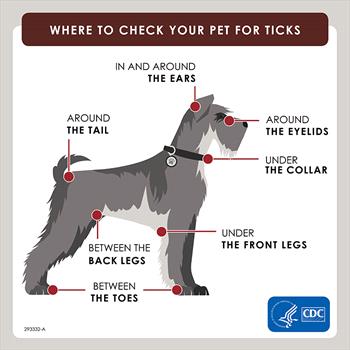Check dog for ticks

Illustration by CDC
Anaplasmosis is a disease of dogs and rarely of cats caused by Anaplasma phagocytophilum. This infectious organism is an unusual type of bacteria known as a rickettsial agent/bacterium. The disease is transmitted to dogs and cats by a tick bite. As with some other tick-borne diseases, a tick must remain attached to the pet for more than 24 hours for the infection to be transferred.
It has been reported from around the world in a variety of animals.
Signs of Anaplasmosis
Signs usually begin 1 to 2 weeks after the tick bite. Anaplasmosis organisms enter the bloodstream and live in the animal’s white blood cells, which normally aid in fighting infections. This invasion of circulating white blood cells creates inflammation throughout the body. Signs can include poor appetite and fever. Joints are commonly affected, making the pet seem stiff or painful or appear to have trouble walking. Sometimes pets may have signs associated with bleeding as well. A bloody nose, dark bloody stool, or bruising may be seen.
Not all pets will have symptoms. Some pets will only appear sick for a short time, then start to improve. We don’t fully understand why this happens, but it may be associated with a pet’s ability to fight off the infection.
Diagnosing Anaplasmosis
A veterinarian’s physical examination is often not useful as a sole means of diagnosis; however, in pets showing signs, it will point the veterinarian in the right direction for testing. A complete blood count, also known as a CBC, may indicate a decrease in red blood cells (anemia), or a decrease in platelets (thrombocytopenia). Sometimes anaplasmosis can be diagnosed by finding the organisms in a blood sample by using a microscope.
Additional lab tests may need to be sent off to confirm the diagnosis. Occasionally, these tests can be positive in a dog or cat who is not showing symptoms. This does not necessarily mean the pet has the disease, but it can mean that they were exposed to it at one point. The veterinarian will then need to take into account the exam, signs, and the rest of the lab work to make a proper diagnosis.
Treatment and Recovery
Anaplasmosis is treated with certain types of antibiotics, most commonly doxycycline.Treatment is usually for 2-4 weeks; the longer course tends to be given if the pet also has Lyme disease, but it all depends on the specific case. Pets usually feel better within a few days after taking the antibiotic. If the anemia or thrombocytopenia are severe, a blood transfusion may also be needed. Most dogs and cats make a full recovery.
Prevention
No vaccine is available to prevent anaplasmosis. The best form of prevention is tick control, either through treating the yard or through applying tick preventive medications to the pet. Consult your veterinarian for the best prevention options for each pet.